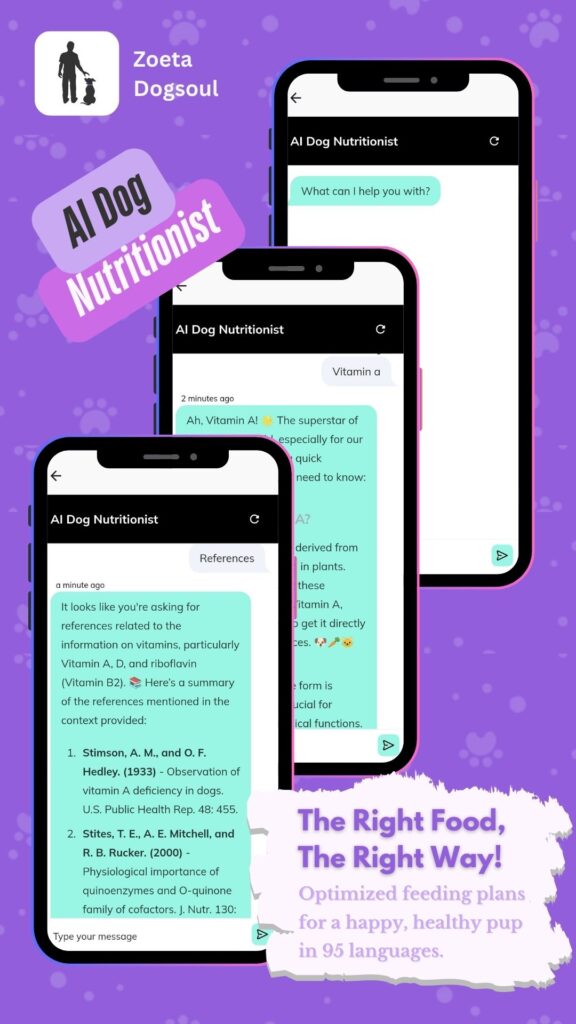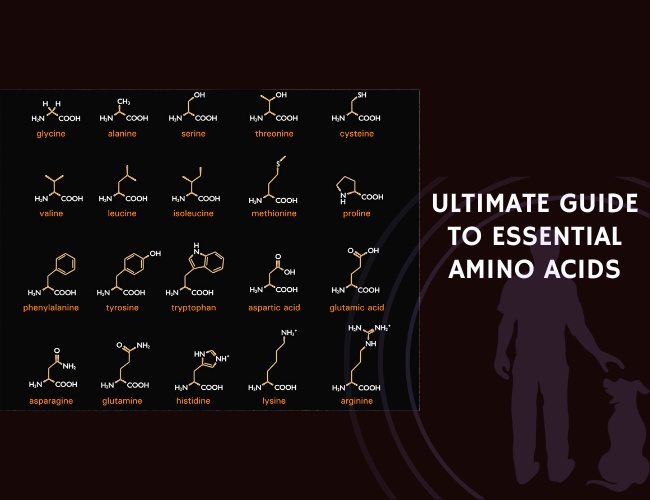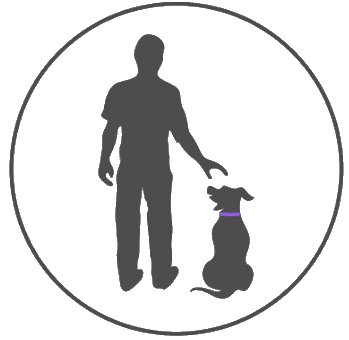Introduction to Essential Amino Acids
Understanding What Essential Amino Acids Are and Why They Matter for Dogs
Amino acids are the building blocks of proteins, which are critical for numerous bodily functions, including tissue repair, muscle growth, and enzyme production. Essential amino acids are those that animals must obtain from their diet, as they cannot be synthesized by their bodies. For dogs, these amino acids are vital for maintaining optimal health, supporting immune function, and ensuring proper development.
The Ten Essential Amino Acids Dogs Need for Survival
Dogs require ten essential amino acids for survival. These are:
- Arginine
- Histidine
- Isoleucine
- Leucine
- Lysine
- Methionine
- Phenylalanine
- Threonine
- Tryptophan
- Valine
Each of these amino acids plays a specific role in the body. For example, lysine is important for proper growth and bone development in puppies, while methionine supports the metabolism and is necessary for the production of other essential compounds. Ensuring your dog’s diet includes these essential amino acids is crucial for their overall well-being.
Why Dogs Can’t Produce These Amino Acids on Their Own
Unlike some nutrients that can be synthesized by the body, essential amino acids must be obtained through diet because dogs lack the enzymes needed to produce them. This inability to synthesize these amino acids internally makes it critical for dog owners to provide a balanced diet that includes high-quality proteins. Failure to meet these dietary needs can lead to various health issues, ranging from poor coat condition to more severe metabolic and immune disorders.
A keen understanding of your dog’s nutritional requirements, particularly regarding essential amino acids, empowers dog owners to make informed decisions about their pets’ diets. Knowledge about these building blocks of life is the foundation upon which a healthy and happy canine existence is built, ensuring they lead vibrant and active lives.
As we delve further into understanding protein sources, it becomes important to compare and choose the most effective dietary components that will meet these essential amino acid needs.
The Role of Protein Sources
Comparison of Animal vs. Plant Protein Sources
Protein sources for dogs come in many forms, with the two primary categories being animal and plant-based proteins. Animal protein sources include meat, fish, poultry, and eggs, while plant-based sources consist of ingredients like legumes, grains, and vegetables. Understanding the distinction between these types is essential for optimizing your dog’s diet.
Animal proteins are often considered superior for dogs because they provide a complete amino acid profile that closely aligns with the dietary needs of carnivorous species. They are rich in all ten essential amino acids: Arginine, Histidine, Isoleucine, Leucine, Lysine, Methionine, Phenylalanine, Threonine, Tryptophan, and Valine.
Plant proteins, on the other hand, can be incomplete in amino acid profiles. While they can contribute to a dog’s overall protein intake, relying solely on plant-based proteins can sometimes result in deficiencies. Plant proteins may lack one or more of the essential amino acids required for a dog’s health. Thus, supplementary sources or combining various plants can be necessary to approximate the complete amino acid profile found naturally in animal proteins.
Why Animal Proteins Are Typically Superior for Dogs
Animal proteins tend to be easier for dogs to digest. The biological composition of animal protein is more compatible with the canine digestive system, ensuring efficient nutrient absorption and utilization. The high digestibility and bioavailability of animal proteins mean that dogs can more readily access and utilize the essential amino acids provided.
Furthermore, animal proteins come packed with other beneficial nutrients that contribute to a dog’s overall health, such as:
- High-quality fats: Essential for energy and cellular functions.
- Vitamins and minerals: Such as B-vitamins, iron, and zinc, which are vital for metabolic processes and immune support.
Because of these factors, animal proteins often contribute to better muscle development, improved immune function, and a healthier coat and skin.
Best Protein Sources for Optimal Amino Acid Intake
When selecting the best protein sources for your dog’s diet, consider those rich in all essential amino acids and easily digestible. Here are some top choices:
- Chicken: Offers a high level of quality protein and is easily digestible.
- Beef: Provides a complete amino acid profile and is a good source of iron and B vitamins.
- Fish (such as salmon): Rich in protein and omega-3 fatty acids that support skin and coat health.
- Eggs: One of the most complete protein sources available, providing almost perfect amino acid profile and high digestibility.
- Turkey: Similar to chicken, turkey is highly digestible and packed with essential nutrients.
Balanced nutrition plays a central role in maintaining your dog’s health, with the right protein sources ensuring they receive all the essential amino acids needed for optimal growth, repair, and overall well-being.
To further ensure your dog’s diet meets their nutritional needs, it is important to monitor not just the type but the quality of the proteins provided. High-quality proteins are more digestible and thus more beneficial for your dog’s health.
Moving forward, it’s crucial to understand how dogs process these proteins and what factors impact their absorption and utilization. This knowledge will help in fine-tuning their diets for better health outcomes.
Understanding Protein Digestibility
What Protein Digestibility Means and Why It Matters
Protein digestibility refers to how effectively a dog’s digestive system can break down proteins and absorb their amino acids. Digestibility is crucial for ensuring that a dog receives the maximum nutritional benefit from their food. High protein digestibility means that a larger proportion of the protein consumed is broken down into amino acids that are absorbed and utilized by the dog’s body. This, in turn, supports vital functions such as muscle maintenance, immune system health, and overall energy levels.
How Dogs Process Different Types of Proteins
Dogs’ digestive systems are designed to process proteins, which are primarily broken down in the stomach and absorbed in the small intestine. There, enzymes and stomach acids work to dismantle protein structures into their component amino acids. These amino acids are then absorbed through the intestinal lining and transported to various parts of the body where they are used for growth, repair, and maintenance.
Different protein sources vary in their digestibility. Animal-based proteins, such as meat, fish, and eggs, are typically more easily digested by dogs due to their amino acid profiles and the presence of enzymes that align with the dog’s natural dietary needs. Plant-based proteins, while valuable, can be less digestible due to fiber content and different amino acid compositions.
Factors Affecting Protein Absorption and Utilization
Several factors influence how effectively a dog can absorb and utilize protein:
- Protein Source: As noted, animal proteins generally have higher digestibility than plant proteins. Choosing high-quality animal protein sources can improve amino acid availability and overall health.
- Processing Methods: Cooking and processing methods can affect protein digestibility. Overcooking or excessive processing can denature proteins, making them harder to digest. Raw or minimally processed proteins tend to retain more of their natural structure and are often more digestible.
- Fiber Content: High fiber content in the diet can interfere with protein absorption by speeding up gut transit time, thereby reducing the opportunity for nutrients to be fully absorbed.
- Age and Health Status: Puppies and senior dogs have different digestive efficiencies. Puppies, with their rapidly growing bodies, require highly digestible proteins to fuel growth. In contrast, older dogs may have diminished digestive function and benefit from easily digestible protein sources.
- Other Nutrients: The presence of other nutrients within the diet, such as fats and carbohydrates, can impact protein absorption. Balancing the overall nutrient profile of a dog’s diet is essential for optimal digestion and health.
Understanding protein digestibility helps dog owners make informed decisions about their pets’ diets to ensure they receive the necessary nutrients for health and vitality. As we continue, we’ll explore the specific protein needs of dogs at various life stages.
Age-Specific Protein Requirements
Protein requirements for dogs vary depending on their life stage. Understanding these needs is crucial for ensuring your canine companion remains healthy and energetic. In this chapter, we will explore the protein needs for growing puppies, adult dogs, and senior dogs, along with tips on how to adjust their protein intake based on their stage of life.
Protein Needs for Growing Puppies vs. Adult Dogs
Growing puppies have significantly higher protein needs than adult dogs. This is because puppies are in a rapid growth phase, developing their muscles, bones, and organs. High-quality, easily digestible protein is vital for supporting this rapid growth and development.
- Growing Puppies: Puppies generally require about 22-32% of their diet to consist of protein. This higher percentage is necessary to support their high metabolic rate and growth demands.
- Adult Dogs: Once dogs reach adulthood, their protein needs decrease slightly, typically requiring around 18-25% protein in their diet. This amount is sufficient to maintain their muscle mass and overall health without overloading their system.
Adjusting Protein Intake Based on Life Stage
As dogs transition from one life stage to another, it’s important to adjust their protein intake accordingly. Here are some tips on making these adjustments:
- Weaning Puppies: Begin by feeding weaning puppies a high-quality, protein-rich puppy food. Gradually introduce them to solid food while ensuring the diet is well-balanced with the necessary vitamins and minerals.
- Adult Transition: When puppies reach about one year of age (or slightly older for larger breeds), transition them to adult dog food. This food typically has slightly less protein than puppy food but is still formulated to maintain muscle and overall health.
- Monitoring Weight and Activity: Keep an eye on your dog’s weight and activity level. Active dogs, even as adults, may require more protein to support their energy needs. Conversely, less active dogs may need slightly less protein to prevent excess weight gain.
Special Considerations for Senior Dogs
Senior dogs have their own unique protein requirements. As dogs age, their bodies undergo changes that impact their nutritional needs. Here are some key considerations for feeding senior dogs:
- Digestibility: Senior dogs may have diminished digestive function, making it harder for them to break down and absorb nutrients. High-quality, easily digestible protein sources are essential to ensure they get the nutrients they need without straining their digestive systems.
- Muscle Maintenance: Aging dogs often experience muscle loss, known as sarcopenia. Maintaining adequate protein intake helps preserve muscle mass and keeps them active and mobile.
- Protein Amount: Generally, senior dogs still require a good amount of protein, but it should be from sources that are gentle on their stomachs. Consulting with a veterinarian can help determine the exact amounts based on your dog’s health and lifestyle.
Adjusting your dog’s protein intake based on their life stage is essential for maintaining their health and well-being. By tailoring their diet to their specific needs at different stages of life, you can help ensure they live a long, happy, and healthy life.
Ensuring your dog has the right diet requires more than just understanding protein requirements. To make the best choices, it’s important to know how to read pet food labels and select high-quality protein sources.
Signs of Protein and Amino Acid Deficiency
Common Symptoms of Insufficient Protein Intake
Protein is essential for your dog’s health and well-being, and a lack of it can lead to several noticeable symptoms. If your dog’s diet lacks adequate protein, you might observe:
- Poor coat condition: A dull, brittle, and thin coat is often one of the first signs of protein deficiency. Dogs may also experience excessive shedding and a lack of luster in their fur.
- Weight loss and muscle wasting: Insufficient protein can cause your dog to lose weight or muscle mass, leading to a generally poor bodily condition.
- Reduced energy levels: Protein is a crucial energy source, and deficiencies can result in lethargy and a decrease in your dog’s overall activity level.
- Slow wound healing: Protein is vital for tissue repair and immune function. Dogs with protein deficiencies may experience slower wound healing and increased susceptibility to infections.
- Behavioral changes: Some dogs may become irritable or exhibit other behavioral changes due to the discomfort associated with a protein-deficient diet.
How to Recognize Amino Acid Deficiencies in Your Dog
Each of the ten essential amino acids that dogs cannot produce has a unique role in their body. Deficiencies in specific amino acids can cause specific symptoms, including:
- Arginine deficiency: Can lead to ammonia toxicity, which presents as vomiting, lethargy, and neurological issues.
- Histidine deficiency: May result in cataracts and hemolytic anemia over time.
- Isoleucine deficiency: Often noticed through skin lesions, hair loss, and poor growth in young dogs.
- Leucine deficiency: Typically results in stunted growth and muscular atrophy, as well as energy imbalances.
- Lysine deficiency: Can cause hair depigmentation, abnormal reproductive functions, and impaired mobility.
- Methionine deficiency: Results in poor coat quality, reduced growth rates, and secondary skin infections.
- Phenylalanine deficiency: Can lead to neurological disturbances and changes in coat color due to its role in melanin production.
- Threonine deficiency: Commonly presents with symptoms such as ataxia, muscle spasms, and decreased immune response.
- Tryptophan deficiency: Seen through aggression, poor growth, and impaired serotonin production.
- Valine deficiency: Noticeable through stunted growth, neurological damage, and various metabolic disruptions.
When to Consult a Veterinarian
If you suspect your dog is experiencing protein or amino acid deficiency based on the aforementioned symptoms, it’s crucial to seek veterinary advice. A veterinarian can:
- Conduct a thorough examination to assess your dog’s condition.
- Perform necessary diagnostic tests to determine if a deficiency is present and identify the underlying cause.
- Recommend an appropriate diet adjustment to address the deficiency.
- Monitor your dog’s response to dietary changes and make further adjustments as needed.
Thorough evaluation and prompt intervention are key to preventing long-term health problems and ensuring your dog receives all the essential nutrients they need.
Shifting our attention to selecting the appropriate diet for your dog, understanding how to read pet food labels for protein content and quality will come in handy. It’s important to ensure a balanced nutritional intake for optimal health and well-being.
Choosing the Right Diet
How to Read Pet Food Labels for Protein Content
Understanding pet food labels is crucial to ensure your dog gets adequate protein. The Association of American Feed Control Officials (AAFCO) sets guidelines for pet food labeling. Here’s how to interpret labels:
- Guaranteed Analysis: This section lists minimum percentages of crude protein, fat, fiber, and moisture. For proteins, look for a minimum of 18% for adult dogs and 22% for puppies.
- Ingredient List: Ingredients are listed by weight in descending order. High-quality protein sources should appear near the top. Common high-quality proteins include chicken, beef, fish, and eggs.
- Nutritional Adequacy Statement: Indicates if the food meets AAFCO standards for a specific life stage (e.g., puppy, adult, senior).
When assessing protein content, focus on the quality and digestibility of the protein sources listed.
Selecting High-Quality Protein Sources in Dog Food
High-quality protein sources are essential for providing the necessary amino acids. Here are some of the best options:
- Animal Proteins: Generally more bioavailable and digestible for dogs. Look for whole meats like chicken, beef, fish, turkey, and eggs. Meat meals (e.g., chicken meal) are also good as they are highly concentrated sources of protein.
- Plant Proteins: Include soy, lentils, peas, and chickpeas. While these can supplement protein intake, they should not be the primary source due to lower bioavailability and incomplete amino acid profiles.
- Novel Proteins: For dogs with allergies, novel proteins like venison, duck, or kangaroo may be beneficial.
Balancing Protein Intake with Other Nutritional Needs
While protein is crucial, a balanced diet must also include fats, carbohydrates, vitamins, and minerals. Here’s how to balance these nutrients:
- Fats: Essential for energy, skin, and coat health. Look for sources like chicken fat, fish oil, and flaxseed.
- Carbohydrates: Provide energy and support digestive health. Good sources include sweet potatoes, brown rice, and oats.
- Vitamins and Minerals: Ensure your dog’s food includes essential vitamins (A, D, E, K, B-complex) and minerals (calcium, phosphorus, zinc, and iron) from natural sources or supplements.
Check the pet food’s overall nutritional profile to confirm it meets AAFCO standards for complete and balanced nutrition.
Transition to Next Topic
Recognizing symptoms such as poor coat condition, weight loss, reduced energy, and behavioral changes can indicate protein deficiency in dogs. Amino acid deficiencies may cause specific symptoms, including arginine deficiency leading to ammonia toxicity and histidine deficiency resulting in cataracts. Consult a veterinarian if symptoms are observed as they can assess the condition, perform diagnostic tests, and recommend dietary adjustments.

Monitoring and Maintaining Optimal Health
Regular Health Checks and Protein Intake Assessment
Ensuring your dog maintains optimal health requires regular health checks and consistent assessment of their protein intake. Routine veterinary visits help monitor your dog’s overall condition and identify any signs of protein or amino acid deficiencies early on. During these check-ups, veterinarians will assess your dog’s weight, muscle condition, coat quality, and overall vitality. These indicators can help determine if your dog’s diet is meeting their nutritional needs or if adjustments are necessary.
Adjusting Diet Based on Activity Level and Health Status
Dogs have varying energy requirements based on their activity levels and health status. Active dogs, such as working or highly energetic breeds, demand higher protein and caloric intake to support muscle repair and energy expenditure. Conversely, less active dogs or those with health issues may need a diet adjusted to prevent weight gain or exacerbation of underlying conditions.
When adjusting your dog’s diet, consider the following factors:
- Activity Level: Highly active dogs need a protein-rich diet to sustain their energy. For instance, a Border Collie involved in agility training will need more protein than a sedentary Basset Hound.
- Health Status: Dogs with specific health issues like kidney disease may require tailored protein levels to avoid worsening their condition. Always consult with your vet before making dietary changes.
Working with Veterinarians for Personalized Nutrition Plans
A tailored nutrition plan developed in collaboration with a veterinarian ensures your dog receives the optimal balance of nutrients for their unique needs. Veterinarians can provide personalized recommendations based on your dog’s breed, age, activity level, and health status. This individualized approach accounts for any specific dietary needs, ensuring a balanced intake of proteins, fats, carbohydrates, vitamins, and minerals.
By working closely with a vet, you can also:
- Monitor Progress: Regular follow-ups help track your dog’s health improvements and adjust the diet as needed.
- Manage Health Conditions: Specialized diets can help manage chronic conditions, improve overall health, and enhance the quality of life.
- Receive Professional Guidance: Vets can offer insights and recommendations on the best commercial diets or homemade recipes to meet your dog’s nutritional requirements.
A holistic approach involving routine health assessments, diet adjustments based on lifestyle, and veterinary consultation ensures a well-rounded and healthy diet. Maintaining these practices supports your dog’s well-being, allowing them to thrive in all stages of life.



